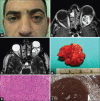Myths in the Diagnosis and Management of Orbital Tumors
- PMID: 26692710
- PMCID: PMC4660525
- DOI: 10.4103/0974-9233.167823
Myths in the Diagnosis and Management of Orbital Tumors
Abstract
Orbital tumors constitute a group of diverse lesions with a low incidence in the population. Tumors affecting the eye and ocular adnexa may also secondarily invade the orbit. Lack of accumulation of a sufficient number of cases with a specific diagnosis at various orbital centers, the paucity of prospective randomized studies, animal model studies, tissue bank, and genetic studies led to the development of various myths regarding the diagnosis and treatment of orbital lesions in the past. These myths continue to influence the diagnosis and treatment of orbital lesions by orbital specialists. This manuscript discusses some of the more common myths through case summaries and a review of the literature. Detailed genotypic analysis and genetic classification will provide further insight into the pathogenesis of many orbital diseases in the future. This will enable targeted treatments even for diseases with the same histopathologic diagnosis. Phenotypic variability within the same disease will be addressed using targeted treatments.
Keywords: Adenoid Cystic Carcinoma; BRAF; Basal Cell Carcinoma; Cavernous Hemangioma; Cetuximab; Epidermal Growth Factor Receptor; Fluid-Fluid Levels; Hedgehog Pathway; Idiopathic Orbital Inflammation; MYB; Optic Glioma; Orbitotomy; Receptor Tyrosine Kinase Inhibitor; Schwannoma; Sorafenib; Squamous Cell Carcinoma; Targeted Treatment; Vismodegib.
Figures




Similar articles
-
Simultaneous diagnosis of ipsilateral adenoid cystic carcinoma of the lacrimal gland and orbital cavernous hemangioma: case report.Orbit. 2014 Aug;33(4):283-5. doi: 10.3109/01676830.2013.842254. Epub 2014 Apr 30. Orbit. 2014. PMID: 24786224
-
[Endoscopic transethmoidal resection of medial orbital lesions].Zhonghua Yan Ke Za Zhi. 2015 Aug;51(8):569-75. Zhonghua Yan Ke Za Zhi. 2015. PMID: 26696572 Chinese.
-
The posterior inferior orbitotomy.Ophthalmic Plast Reconstr Surg. 1998 Jul;14(4):277-80. doi: 10.1097/00002341-199807000-00010. Ophthalmic Plast Reconstr Surg. 1998. PMID: 9700737
-
Metastatic tumors of the orbit and ocular adnexa.Curr Opin Ophthalmol. 2007 Sep;18(5):405-13. doi: 10.1097/ICU.0b013e3282c5077c. Curr Opin Ophthalmol. 2007. PMID: 17700235 Review.
-
Cavernous venous malformation (cavernous hemangioma) of the orbit: Current concepts and a review of the literature.Surv Ophthalmol. 2017 Jul-Aug;62(4):393-403. doi: 10.1016/j.survophthal.2017.01.004. Epub 2017 Jan 26. Surv Ophthalmol. 2017. PMID: 28131871 Review.
Cited by
-
Ocular morbidity among children (aged 6-18 yr) of the tribal area of Melghat, India: A community-based study.Indian J Med Res. 2023 Oct 1;158(4):370-377. doi: 10.4103/ijmr.ijmr_3228_21. Epub 2023 Sep 25. Indian J Med Res. 2023. PMID: 38006342 Free PMC article.
-
Orbital Apex Malignant Lymphoma Diagnosed Using Whole-Body Computed Tomography.Cureus. 2025 Mar 25;17(3):e81191. doi: 10.7759/cureus.81191. eCollection 2025 Mar. Cureus. 2025. PMID: 40291256 Free PMC article.
-
[Alternative treatment options for periorbital basal cell carcinoma].Ophthalmologe. 2020 Feb;117(2):113-123. doi: 10.1007/s00347-019-01021-4. Ophthalmologe. 2020. PMID: 31811367 Review. German.
References
-
- Rosenbaum J, Choi D, Harrington C, Harris G, Czyz G, White V, et al. Identifying and classifying nonspecific orbital inflammation (NSOI) Invest Ophthalmol Vis Sci. 2013;54:2035. - PubMed
-
- Pasquali T, Schoenfield L, Spalding SJ, Singh AD. Orbital inflammation in IgG4-related sclerosing disease. Orbit. 2011;30:258–60. - PubMed
-
- Harris GJ, Jakobiec FA. Cavernous hemangioma of the orbit. J Neurosurg. 1979;51:219–28. - PubMed
-
- Scheuerle AF, Steiner HH, Kolling G, Kunze S, Aschoff A. Treatment and long-term outcome of patients with orbital cavernomas. Am J Ophthalmol. 2004;138:237–44. - PubMed
Publication types
MeSH terms
Substances
LinkOut - more resources
Full Text Sources
Other Literature Sources
Research Materials
Miscellaneous

